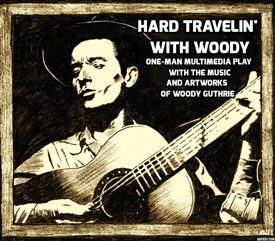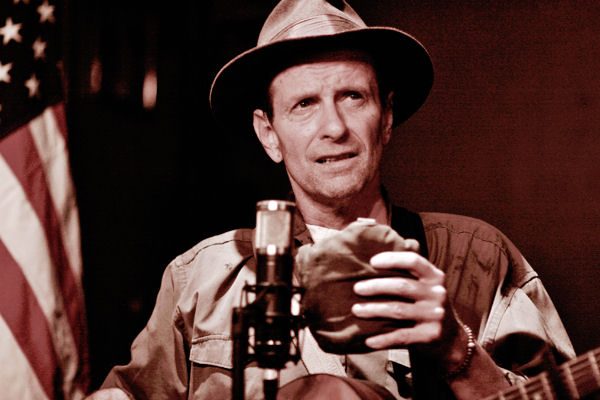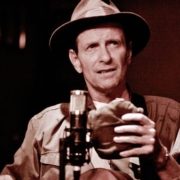Hard Travelin’ with Woody
Written and Performed by Randy Noojin
The Theatre Asylum’s Elephant Studio
At The Hollywood Fringe Festival – June 23, 2014
 Woody Guthrie is still out there, like the Force, unencumbered and unfettered by normal social constraints or personal obligations that most of us take for granted. Just him and his guitar and harmonica – ramblin’ around from town to town, lending his voice to the cause of the working people. He reminds us that “working people” includes hoboes like himself—one of the original Dust Bowlers from Okemah, Oklahoma, who got put out on the road by Ma Nature and the Bankers in 1935, and never came home. Woody tells their story and sings the real-life ballads and songs he made up so their story wouldn’t be forgotten.
Woody Guthrie is still out there, like the Force, unencumbered and unfettered by normal social constraints or personal obligations that most of us take for granted. Just him and his guitar and harmonica – ramblin’ around from town to town, lending his voice to the cause of the working people. He reminds us that “working people” includes hoboes like himself—one of the original Dust Bowlers from Okemah, Oklahoma, who got put out on the road by Ma Nature and the Bankers in 1935, and never came home. Woody tells their story and sings the real-life ballads and songs he made up so their story wouldn’t be forgotten.
I’ve heard others do this kind of one-man theatre before, starting with Tom Taylor at the Theatricum Botanicum in the 1980s, and more recently Will Kaufman, British author of Woody Guthrie: American Radical (University of Illinois Press, 2011) during the Centennial of Woody’s birth (on July 14, 1912) a couple of years ago. No one quite captures Woody’s indomitable life-affirming spirit quite so believably as Indiana-born, New York actor/singer/playwright Randy Noojin, who brought his critically acclaimed one-man show to the Hollywood Fringe Festival this week, with two shows yet to go. And I include Woody’s own son Arlo in that assessment.
Randy Noojin’s Woody seems haunted, obsessed by and determined to rise above the poverty that was forced upon him and his generation of “Okies.” They were Dust Bowl refugees who faced down the worst natural disaster ever visited upon our fellow citizens during the Great Depression and left the Great Plains of rolling fertile farms vanquished by high winds and dry dust that literally blew them right off their land. The same land Woody would later celebrate and honor in his most famous song, which Randy Noojin beautifully circles all around until he finally brings his one-hour portrait of America during the hardest of hard times, to a rousing close. He builds this on the small and finely etched portraits of the people—the old-timers, farmers, settlers, mothers, fathers and children, union organizers, hoboes and yes, the bankers he met along the way—to end on a resilient “note of hope.”
What distinguishes Randy Noojin’s illuminating portrait of Woody from all the others I’ve seen is that he has resolutely let Woody speak (and sing) for himself; this is Woody Guthrie unfiltered in his own words—but assembled by a master craftsman from Woody’s autobiography Bound for Glory, his intermediate songbook with a long, detailed and rhapsodic introduction American Folksong (Oak Publications, 1961), his anthology of shorter prose writings, Born to Win (MacMillan, 1967), his collected People’s World newspaper columns Woody Sez (Grosset and Dunlap, 1975) and various anecdotes that found their way into an earlier stage production by Millard Lampell (of the Almanac Singers), California to the New York Island. From a dozen different sources Noojin has created a finely woven tapestry of Woody’s life and all-but vanished world, with the organizing thread being Woody’s own voice. It’s a masterful oral history of America in the 1930s and beyond, told by the American folk singer and storyteller who single-handedly created the job description of modern troubadour.
In addition to his amazing dramatic portrait Randy Noojin utilizes all of the tools of modern theatre—which I saw in full display and recently reviewed at the Music Center’s Mark Taper Forum production of Paul Robeson: The Tallest Tree in the Forest. With all the resources of LA’s largest theatre complex—where it cost as much to park as the tickets for these Hollywood Fringe Festival productions—they had nothing on Randy Noojin’s beautiful multi-media enhancement of Woody’s compelling story.
https://www.youtube.com/watch?v=ByG7lPKGLL4
In perfect synchronization from beginning to end, cast against the back wall of the small Asylum Theatre’s Elephant Studio at 1078 Lillian Way (just off 6320 Santa Monica Blvd) in the heart of old Los Angeles, one could see a seamless visual narrative of Woody Guthrie’s drawings and paintings as well as documentary news footage of all the scenes of the real-life Tom Joads and the many Joad families who were thrown out on Highway 66 heading for California and a new start, only to find what John Steinbeck called The Grapes of Wrath, as their search for a job and shelter led them into desperate battles with cops and deputy gun thugs determined to keep California pure of these migrant workers from America’s heartland.
You will meet the real-life preacher Casey who organizes a strike that Woody joins—because the promise of picking peaches at 9 cents a bushel that lured thousands of poor white farm workers who had once been proud owners of their own land to the Central Valley was suddenly revised downward to 4 ½ cents a bushel—on which they couldn’t even feed their families, let alone find any kind of housing. You will hear a migrant mother sing her hungry children to sleep with one of Woody’s wonderful children’s songs—beautifully rendered by Randy Noojin to the stunning backdrop of Woody’s pen-and-ink drawings of the folks who were drawn to the lonesome sound of his acoustic guitar and voice as pure as the earth from which it sprang.
But if music was Woody’s weapon, his raconteur’s sense of humor was his saving grace, and Noojin sprinkles examples of Woody’s wit and wisdom throughout the proceedings. Woody had Will Rogers’ ability to distill large truths into small observations, as when he says “Trouble ain’t worth nothing, so I don’t charge nothing to fix it,” or “I ain’t a communist…necessarily,” or “take it easy, but take it.” He tells some of Woody’s vaudeville-worthy Midwestern jokes, such as how he was able to distinguish a banker’s one good eye from his perfect replica of a glass eye. (No spoiler alert here: go see Randy Noojin’s one-man show for a useful lesson in rural one-upmanship!)
 There have been concentrated efforts over the past few years to make the case that Woody Guthrie was far more than “The Dust Bowl Balladeer,” that folklorist Alan Lomax dubbed him and which made him famous. His daughter Nora Guthrie has unearthed hundreds of unsung and previously unpublished song lyrics in the Woody Guthrie Archives in NYC and farmed them out to contemporary folk musicians here and abroad to set to more complex modern melodies and champion his wide-ranging urban interest in movie stars, baseball and even Klezmer music; all well and good. But in trying to make Woody a folk singer for all occasions, they may have left something worth mentioning behind. When asked how one wants to be remembered even the most talented of earth’s mere mortals have pretty much one line that will fit on their tombstone.
There have been concentrated efforts over the past few years to make the case that Woody Guthrie was far more than “The Dust Bowl Balladeer,” that folklorist Alan Lomax dubbed him and which made him famous. His daughter Nora Guthrie has unearthed hundreds of unsung and previously unpublished song lyrics in the Woody Guthrie Archives in NYC and farmed them out to contemporary folk musicians here and abroad to set to more complex modern melodies and champion his wide-ranging urban interest in movie stars, baseball and even Klezmer music; all well and good. But in trying to make Woody a folk singer for all occasions, they may have left something worth mentioning behind. When asked how one wants to be remembered even the most talented of earth’s mere mortals have pretty much one line that will fit on their tombstone.
Alan Lomax got it right the first time. Woody was, is, and forever will be “The Dust Bowl Balladeer.” All the rest is mere window-dressing on this once-in-a-lifetime role. And this Hollywood Fringe Festival offering of Randy Noojin’s Hard Travelin’ with Woody gets it right too—right down to the 1940s era RCA Victor microphone that is Noojin’s one stage prop. He didn’t get that at Radio Shack.
Go see his play, and when Randy Noojin says—as he often does during this utterly captivating and deeply moving portrait of an artist as a young man—“You sing too!” to some of Woody’s classic songs which are beautifully supported by Noojin’s well-played Martin Guitar and harmonicas, don’t be shy. Woody created these hard-hitting songs for hard-hit people everywhere—even in a small theatre play with some big truths, to remind us to… Take it easy, but take it!
With thanks to Randy Noojin and Hollywood Fringe for a Press Pass and signed copy of the beautiful theatre poster adapted from a classic photo of Woody and his guitar.
HARD TRAVELIN’ WITH WOODY, the critically acclaimed multimedia solo show with the music and artworks of Woody Guthrie, written and performed by Randy Noojin, will perform as part of Hollywood Fringe at Theatre Asylum’s Elephant Studio, 1078 Lillian Way, 90038 on Thursday, June 26th at 10pm and, Saturday, June 28 at 5:30pm. Tickets are $15 or pay-what-you-can and can be purchased at hollywoodfringe.org or at the door. After the Fringe Festival run Randy Noojin is on his way to the next stop on his tour—the National Woody Guthrie Center in Tulsa, Oklahoma. Are they in for a treat!
Ross Altman may be reached at greygoosemusic@aol.com













